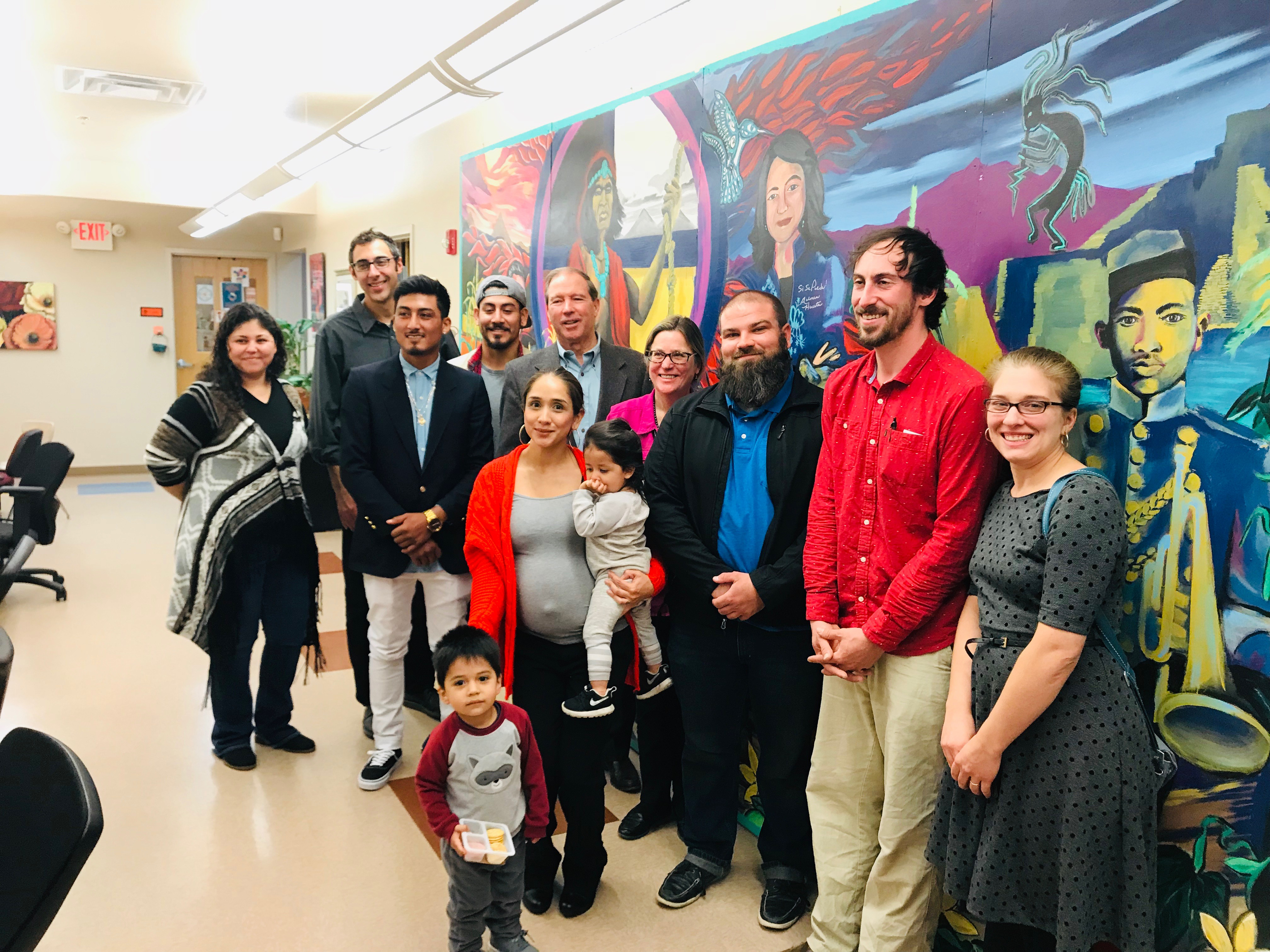
Marisol Atkins
Sen. Tom Udall (fifth from left) poses with Northern New Mexico Youth Homeless Demonstration Project members in October 2018.
When the New Mexico Coalition to End Homelessness applied for a HUD grant on youth homelessness in 2018, they weren’t expected to get funded, said Marisol Atkins, a planning consultant for the Youth Homeless Demonstration Project.
That project (YHDP) is funded by the U.S. Department of Housing and Urban Development. The federal grant has given millions to local communities to build networks to combat youth homelessness.
“They just thought it would be good to apply,” Atkins said.
A few months later, unexpected news arrived: HUD had awarded the coalition (NMCEH) $3.37 million to administer federal funding for 14 northern New Mexico counties, including McKinley, to establish rapid rehousing programs, particularly for youth who have aged out of foster care. New Mexico was one of only 11 nationwide sites to receive this round of HUD funding.
The two-year pilot project, which could be extended if the program is successful, focuses on housing young people 24 and under in rural areas. That includes Native American, LGBTQ+, Hispanic and Latinx youth populations; youth involved in the juvenile justice system, and victims of sexual trafficking and exploitation. The New Mexico YHDP, which might help tamp down New Mexico’s youth homeless numbers to a manageable amount, has been developed by the experience of youth, particularly foster kids who have experienced homelessness.
Approximately 50 youth, 18 to 24 years old, and their 15 small children have been housed in their own dwelling since YHDP implementation first began in October. Of the 65, 16 youth and seven children live in the Gallup area.
“They’re doing incredible so far,” said Atkins about McKinley County’s efforts in housing formerly homeless youth. The rental assistance program, which is moving forward despite the COVID-19 pandemic, pays for a youth to live in their own apartment or other stable living situation for up to 24 months, with an ultimate goal of self-sufficiency.
Housing always a top need
Multiple studies show that housing instability is the leading cause for a litany of poor outcomes for youth, including mental health challenges, suicidal behaviors and adult homelessness. Secure and safe housing remains at the top of the priority list for New Mexico’s vulnerable youth, according to Atkins.
“There was a big needs assessment for the state in 2004 through the Behavioral Health Collaborative, and the top three things that came up were housing, transportation and substance abuse services,” said Atkins, who was the director of the Children, Youth and Families Department (CYFD) during the Bill Richardson administration. “Fast forward to now and it’s the same thing. People most need housing, transportation and substance abuse treatment.”
“I think the [YHDP] program is critical and addresses a longstanding problem, especially for kids in foster care,” she said. “The incidences of homelessness post-exit from the protective services system are hugely high.”
After the NMCEH received the grant, Atkins wrote a 121-page coordinated community plan that included input from the New Mexico Public Education Department, CYFD and youth from all over the northern region of the state who have experienced homelessness.
The YHDP, which also serves unaccompanied pregnant and parenting youth, requires the presence of local youth action boards, with two-thirds of its members either currently homeless or previously housing unstable. “They’re at the forefront with all that we’re doing,” Atkins said.
The NMCEH is collaborating with six community partners throughout northern New Mexico, including Youth Shelters and Family Services, which is helping to rehouse McKinley County youth, and Kewa House at Kewa Pueblo (formerly Santo Domingo Pueblo), which Atkins says is the only emergency shelter for Native American youth in New Mexico and surrounding states. The YHDP also provides supportive services to youth and young adults, such as accessing behavioral health care, employment, child care and healthy food.
More federal funding may come
The program’s ultimate goal is for formerly homeless youth to learn life skills, gain employment, attend school and sign a lease in their own name by the end of the two-year program.
Some of the youth involved in the planning phases said 24 months isn’t enough for some to make sweeping life changes. In special cases, the YHDP may be able to pay the full rent on an apartment for up to 36 months. Atkins says HUD is currently revisiting the program’s overall flexibility due to the coronavirus outbreak.
[Related: COVID-19 Adds to Woes of Homeless New Mexican Youth Who Age Out of Foster Care]
[Related: Year-old Las Cruces Shelter for Homeless Youth Newly Challenged by Coronavirus]
[Related: New Mexico Foster Care Intended to Become ‘Trauma Responsive’ in Lawsuit Settlement]
[Related: COVID-19 Changes in Eddy County Mean Fewer Referrals, More Donations]
During the 2020 legislative session, the state fulfilled a HUD requirement by providing an approximately $413,000 match in the general appropriations budget. If the program does well, Atkins said the NMCEH can ask for recurring funds. Meanwhile, the southern New Mexico counties intend to apply for a new round of HUD funding that’s expected to be announced by summer, though the timing could change due to the novel coronavirus, she said.
Overall, Atkins sees fixing the state’s youth homeless problem as within reach. New Mexico Public Education Department data shows that 10,683 public school students identified themselves as housing unstable during the 2017-18 school year. (HUD’s youth homeless numbers, which are determined by a Point in Time count every other year, are much lower compared to a state’s public education survey.)
“We don’t have the [homeless] numbers like inner-city Chicago or New York or San Francisco so there’s no reason why we can’t eliminate youth homelessness in New Mexico,” she said. California, which has a significantly higher overall population compared to New Mexico, counted 263,058 public school students who had experienced homelessness.
“It’s totally doable,” Atkins said. “We just need to set up a culture in which this is something we do and that the young people know that it’s not going to be a bad foster care scene, that people care about them, and will help support them in their independence.”
This story is part of a Youth Today project on foster care in New Mexico. It’s made possible in part by the May and Stanley Smith Charitable Trust. Youth Today is solely responsible for the content and maintains editorial independence.



























